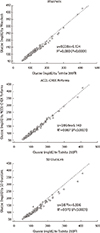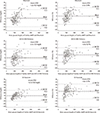Abstract
Background
Glucometers are widely used for self-monitoring and point-of-care testing in diabetes management. We evaluated the performance of the recently developed Wisecheck Glucose Monitoring System (Wisemeditech, Korea) compared to that of 2 other well-known glucometer systems.
Methods
The Wisecheck glucometer was evaluated for precision, linearity, and carryover rate. One-hundred fifty samples samples were tested, and the results obtained from the Wisecheck glucometer, ACCU-CHEK Performa (Roche Diagnostics, Germany) and SD GlucoLink (SD Diagnostics, Korea) were compared to those obtained using the laboratory reference method from the Toshiba 200FR (Toshiba, Japan), according to the Clinical and Laboratory Standards Institute (CLSI) guidelines.
Results
The coefficient of variation (CV) values for within-run imprecision at low, middle, and high levels were 2.06%, 1.02%, and 2.02%, respectively, and the CV values for total-run imprecision at low, middle, and high levels were 2.98%, 2.41%, and 1.88%, respectively. In the linearity test, the coefficient of determination (R2) was 0.9985 in glucose concentration ranging from 48.6 mg/dL to 428 mg/dL (P<0.0001). The results obtained using the Wisecheck glucometer were well correlated with those obtained using the Toshiba 200FR (R2=0.980, P<0.0001). The carryover rate was 0.12%.
Figures and Tables
 | Fig. 2Correlation of glucose concentrations measured using 3 glucometers (Wisecheck, ACCU-CHEK Performa, and SD GlucoLink) with those measured using Toshiba 200FR. |
 | Fig. 3Bland-Altman difference plots and Bland-Altman % difference plots of the mean values obtained using the glucometers, Wisecheck, ACCU-CHEK Performa, and SD GlucoLink versus those obtained using Toshiba200FR. The mean difference (solid line) and limits of agreement (mean±2SD, dotted line) are shown. |
References
1. Cho NH. Diabetes epidemiology in Korean. J Korean Diabetes Assoc. 2001; 25:1–10.
2. American Diabetes Association. Standards of medical care for patients with diabetes mellitus. Diabetes Care. 2003; 26:S1. S33–S50.
3. Yoo EH, Cho HJ, Ki CS, Lee SY. Evaluation of COSMOsensor Glucose Monitoring System. Korean J Lab Med. 2006; 26:1–8.

4. Park CY, Ryu MS, Woo JT, Kim SW, Kim JW, Kim YS, et al. Evaluation of GlucoDrTM blood glucose testing system. Clin Diabetes. 2002; 3:152–163.
5. Frias JP, Lim CG, Ellison JM, Montandon CM. Review of adverse events associated with false glucose readings measured by GDH-PQQ-based glucose test strips in the presence of interfering sugars. Diabetes care. 2010; 33:728–729.

6. Bode Bruce W. The accuracy and interferences in self-monitoring of blood glucose. US Endocr Dis Touch Brief. 2007; 46–48.
7. Lee SY, Lee NY, Kim JW. Evaluation of 6 glucose testing system. Korean J Lab Med. 2003; 23:170–179.
8. Clinical and Laboratory Standards Institute. User verification of performance for precision and trueness; approved guideline. EP15-A2. 2nd ed. Wayne, PA: Clinical and Laboratory Standards Institute;2006.
9. Clinical and Laboratory Standards Institute. Evaluation of the linearity of quantitative measurement procedures; a statistical approach.; approved guideline. EP6-A. Wayne, PA: Clinical and Laboratory Standards Institute;2003.
10. Clinical and Laboratory Standards Institute. Method comparison and bias estimation using patient samples; approved guideline. EP9-A2. 2nd ed. Wayne, PA: Clinical and Laboratory Standards Institute;2002.
11. Bland JM, Altman DG. Statistical methods for assessing agreement between two methods of clinical measurement. Lancet. 1986; 1:307–310.

12. Clinical and Laboratory Standard Institute. Point-of-care blood glucose testing in acute and chronic care facilities; approved guideline. 3rd ed. Wayne, PA: Clinical and Laboratory Standard Institute;2013. POCT12-A3.
13. The International Organization for Standardization. In vitro diagnostic test systems-requirements for blood glucose monitoring systems for self-testing in managing diabetes mellitus. ISO/TC 212/SC. International Standard ISO 15197. Geneva, Switzerland: ISO;2003.
14. Clinical and Laboratory Standards Institute. Method comparison and bias estimation using patient samples; approved guideline. EP9-A2. 2nd ed. Wayne, PA: Clinical and Laboratory Standards Institute;2002.
15. Intensive blood-glucose control with sulphonylureas or insulin compared with conventional treatment and risk of complications in patients with type 2 diabetes (UKPDS 33). UK Prospective Diabetes Study (UKPDS) Group. Lancet. 1998; 352:837–853.
16. Amin R, Ross K, Acerini CL, Edge JA, Warner J, Dunger DB. Hypoglycemia prevalence in prepubertal children with type 1 diabetes on standard insulin regimen: use of continuous glucose monitoring system. Diabetes Care. 2003; 26:662–667.

17. National standards for Diabetes Self-Management Education Programs and American Diabetes Association review criteria. Diabetes Care. 1995; 18:737–741.
18. Clarke SF, Foster JR. A history of blood glucose meters and their role in self-monitoring of diabetes mellitus. Br J Biomed Sci. 2012; 69(2):83–93.

19. Price CP, Hicks JM, editors. Point-of-care testing. 1st ed. Washington: American Association for Clinical Chemistry, Inc.;1999.




 PDF
PDF ePub
ePub Citation
Citation Print
Print




 XML Download
XML Download